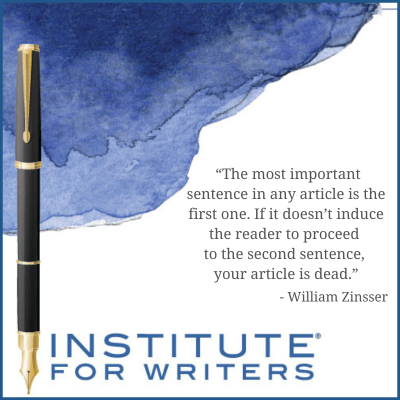
Influential Female Authors: Past, Present, and Rising
We’re going to look at influential female authors of the past, those impacting the present, and whom the industry expects to make a big splash.

The lead that opens an article often seems like the most challenging part to write. This is our chance to “hook” readers by convincing them our topic is interesting, useful, informative, and/or entertaining enough to deserve their time and attention. And we must act fast.
 As William Zinsser said in On Writing Well, “The most important sentence in any article is the first one. If it doesn’t induce the reader to proceed to the second sentence, your article is dead. And if the second sentence doesn’t induce him to continue to the third sentence, it’s equally dead.”
As William Zinsser said in On Writing Well, “The most important sentence in any article is the first one. If it doesn’t induce the reader to proceed to the second sentence, your article is dead. And if the second sentence doesn’t induce him to continue to the third sentence, it’s equally dead.”
Writing a great article lead might be challenging, but it can be done. Here are tips from the pros.
Consider your audience.
What do your readers need and/or want to know? This will help you focus both your article and lead. Also, study the “personalities” of different publications and notice how they present information, e. g. The Wall Street Journal, National Geographic, Good Housekeeping, Vogue, Psychology Today, Rolling Stone, Sports Illustrated, Southern Living, The Christian Science Monitor, Military Times, Cosmopolitan, People, USA Today. What writing styles do you see? As Art Spikol says in Magazine Writing: The Inside Angle: “One editor’s lead is another editor’s boredom.”
Get to the point.
Identify your main topic and purpose quickly. If your article lead includes background material, ask yourself what readers need to know and when they need to know it. Then blend in relevant details as you move along. As for personal details, Moira Allen, author of Starting Your Career as a Freelance Writer advises, “If the first three or four paragraphs are about you, and the rest of the article is not about you, that’s a real clue those paragraphs need to go!”
How long?
There’s no fixed rule, but article leads generally require one paragraph, sometimes two. It depends on your topic and the publication. Straight news leads might run only 30-40 words. Editors note that too-long leads can lose their impact, even when well written.
Don’t promise too much.
Leads make a sort of promise to readers about what they’ll gain from the article. Don’t promise anything you can’t or won’t deliver ( e. g.: “A change in diet can cure any disease.”). Be intriguing but clear, and don’t make the lead more exciting than the article, say the pros.
Other things to avoid:
Leads with cliches, tangled sentences, redundancies, puns, and too-flowery language.
You can choose a summary-type lead or something more creative and descriptive. Here are several types you have seen, and maybe used. They can be combined, as when a quote also makes a striking remark.
Straight News Lead
These article leads directly show the article’s content, purpose, and importance. They’re common in news pieces that intend to be impartial. In the June 2024 issue of AARP Bulletin, Beth Braverman began her article “Protect Your Home Against Rising Waters” in this straightforward way: “As floodplains expand and serious storms become more frequent, U.S. homes are at ever-greater risk of water damage.”
 Summary Lead
Summary Lead
A Summary Lead packs information up front. Nick Wolny says that it aims “… to communicate most of the who, what, where, when, why, and how of your story … in a single sentence.”
Single Item Lead
A Single Item Lead focuses more narrowly on the topic: “The Los Angeles Dodgers became the first team ever to win the World Series after overcoming a five-or-more run deficit in the deciding game.”
Anecdote
A realistic anecdote takes readers “on the scene” to engage their emotions and curiosity. Nonfiction anecdotes must be true unless a given publication permits hypotheticals. Here’s an example from the article “Watching Whales Watching Us” (Charles Siebert, The New York Times Magazine, July 12, 2009): “On the afternoon of Sept. 25, 2002, a group of marine biologists vacationing on Isla San Jose, in Baja California Sur, Mexico, came upon a couple of whales stranded along the beach. A quick assessment indicated that they had died quite recently.”
Atmospheric Lead (also called Descriptive or Scene-Setting)
These article leads use details, especially sensory details, to create a sense of place and/or time. They often launch articles about travel, food/restaurants, and historical events, among others. From Jessica Stone’s article “Tapping for Maple’s Sweet Gold”: “In early spring, as the maple trees start their new growth spurts, the sap within them that remained frozen for months begins to thaw. This is what sugar-makers wait for all year long [a time when sugar houses] are busy tapping maple trees of their sap—a clear, slightly sweet liquid that is boiled down to a sweet syrup.” (American Spirit, March-April 2007).
 Case History Lead
Case History Lead
In How to Sell the Eight Easiest Article Types, Helen Schellenberg Barnhart writes that using case histories like those that might appear in police files or medical records enable authors to give “a lot of information, in the fewest possible words, details necessary to the reader’s understanding of the problem which unfolds in dramatic form after the case history.” She suggests that using this lead in expose’ articles “… provides the background material on the subjects prior to the main event that the article focuses on.”
Delayed Identification
These leads arouse interest by portraying a person, place, or object before identifying them. Editors suggest that writers not wait too long before identifying their subject—by the end of the lead paragraph, for example.
Dialogue
Here, readers witness a provocative verbal exchange. Such leads may appear in historical pieces or personal experience, self-help, and parenting articles, for example. Here’s one I invented:
“You aren’t going to the party,” Stu told his 15-year-old son Bret. “No adults will be there.”
Bret snapped, “That’s not fair. Everyone else is going. You just don’t want me to have fun.”
Question
Question leads are versatile and popular, though some editors dislike them. Use questions with care, avoiding those with obvious answers. Questions that give surprising facts can spark curiosity or promote changes in attitude or behavior. Questions can also express something readers themselves have thought, sometimes using humor or irony. Here’s how Gary Provost started “The 7 Beacons of Excellent Writing”: “Did you ever sit down to write, and get the feeling that things would go fine if you could just keep in mind 543 principles of good writing? I did. A lot.”
 Quote
Quote
Quote leads can come from well-known people, authorities, or unknown people with something relevant or interesting to say. Some leads employ an old maxim or proverb that reflects the article topic.
Startling or Surprising Lead / Zinger
Leads can reveal facts or statistics that surprise, shock, alarm, or amaze the reader. This lead from Aida Elder features a surprise, laced with humor: “Sleigh bells ringing . . . Jack Frost nipping . . . chestnuts roasting . . . and mountain biking? No, it’s not the sour eggnog talking. You really can include mountain biking in this catalogue of things winter.” (“When ‘Tis(n’)t the Season to Ride?” Silent Sports, January 2008).
Here’s one from an article entitled “You Now Have a Shorter Attention Span Than a Goldfish”: “The average attention span for the notoriously ill-focused goldfish is nine seconds, but according to a new study from Microsoft Corp., people now generally lose concentration after eight seconds, highlighting the affects [sic] of an increasingly digitalized lifestyle on the brain.” (Kevin McSpadden, Time, May 14, 2015)
And here’s an invented Zinger: He thought he was a good Samaritan. Instead, he got arrested.
Once you’ve written your article, re-check your lead. In an article for Writer’s Digest, Gary Provost says, “What is the implied promise to readers? Have you kept that promise? . . . Remember, the more you promise, the more you must deliver.” If you researched and organized your material well and wrote clearly, with a suitable style and tone, the readers you “hook” will likely stay with you. As you leave this article, I hope you feel better prepared to write strong article leads.
Victoria Sherrow has published short stories, articles, poetry, and books (fiction and nonfiction) for readers of all ages. Her books have received starred reviews and been honored by the American Library Association, Parents Choice Gold Award, National Association for the Advancement of Science, and NYPL Best Books for the Teenage, among others. Victoria has taught at The Institute of Children’s Literature for more than 25 years and enjoys seeing her students master strong beginnings for both their fiction and nonfiction writing.

We’re going to look at influential female authors of the past, those impacting the present, and whom the industry expects to make a big splash.

This week, we’re focusing on how we as writers can create strong female characters that others will look up to, instead of harmful stereotypes.

Is your writing routine reaching its potential? Maybe it’s time to take another look so you can see what’s possible for your writing.
1000 N. West Street #1200, Wilmington, DE 19801
© 2024 Direct Learning Systems, Inc. All rights reserved.

1000 N. West Street #1200, Wilmington, DE 19801
© 2025 Direct Learning Systems, Inc. All rights reserved.

1000 N. West Street #1200, Wilmington, DE 19801
©2025 Direct Learning Systems, Inc. All rights reserved. Privacy Policy.